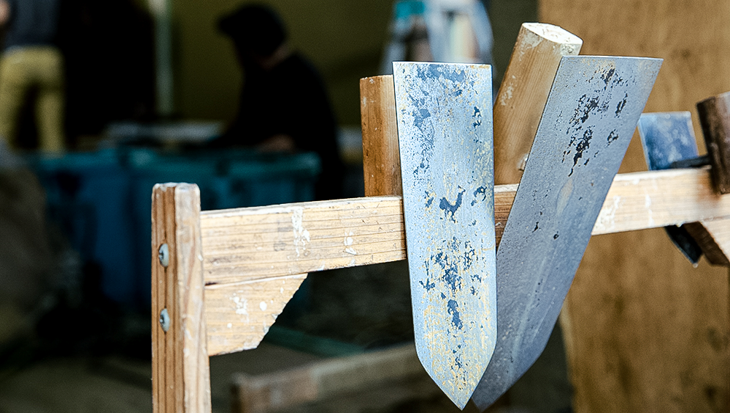
April 21, 2025
The tool is a treasure of 30 years - the story of a plasterer's trowel, carefully wrapped in cloth.
People who do first-class work take better care of their 'tools'.
I came to believe this after meeting a plasterer.
I will never forget what he said.
-- "Caring for a dirty trowel is like polishing yourself."
In this article, we would like to explore how we should handle the tools we use in our daily work, drawing on an encounter with a plasterer.
Plaster exterior wall site, beautiful and emotional plasterer's hands.

The author used to work in the construction industry. Essentially, I worked in-house, but when there was a shortage of labor, I occasionally went to construction sites as an assistant site foreman.
At one point, I was working at the site of a multi-section detached house. The "plastered exterior walls" by the entrance were a distinctive feature.
The dynamic finish of the plasterer's plasterwork was also well received at other sites. The appearance of the plastered walls varied from house to house, even within the same series of houses.
Plaster is applied to the wall surface using a trowel. The plasterers' finishing work on the plaster walls was beautiful and expressive.
The plasterer stands in front of the wall surface with a trowel in his right hand and a trowel board with plaster on it in his left hand.
With a flick of the right wrist holding the trowel, he scoops the plaster and applies it to the wall surface.
The trowel is tilted at an angle in a specific direction while applying the plaster, sometimes to increase the thickness, sometimes to remove it, creating a layer of plaster.
Rhythmically, powerfully, yet delicately. The freedom they had to work on the walls with a single trowel was thrilling to watch, no matter how many times I saw it.
The walls created by their handiwork seem to give the houses their 'humanity'. They transform the atmosphere and create a unique presence.
Caring for a dirty iron is like polishing yourself.

One day, I was with a familiar plasterer at the end of his workday on the site.
The trowels used to apply the plaster need immediate care, as the plaster will harden if left in place.
While sweeping the site, I approached the plasterer, who was in the process of carefully removing the plaster from the trowels.
Wet with water, the surface is gently scrubbed with a brush, and then the water is wiped away with a white cloth to reveal a shiny silver blade.
"It's beautiful..." When the words slipped out unconsciously, the craftsman laughed a little, as if embarrassed,
"I've been using it for 30 years now," he says. "Thirty years, eh?
"Thirty years? Yes, I've been using it for 30 years now. Without it, I wouldn't be able to do my job. It's just like my hand."
I was speechless. I felt I could see 30 years of history behind the way he looked at the trowel with narrowed eyes.
The craftsman told me this story while oiling the trowel.
"Taking care of a dirty trowel is like polishing yourself. If you leave it dirty, you will be dirty too. If you leave it rusty, you'll leave yourself rusty too. If I polish it so that it's always in tip-top condition, then so will I."
After cleaning, he wrapped the trowel in a soft cloth.
"My tools are probably the only treasures in the world. I don't want to sell them, no matter how much money they bring in. I've got all my work here."
The value of work, born of treasure.

Watching the craftsman handle the trowel with such love and care, I felt I understood why people admired the walls he created.
'It looks like art!'
'It feels very, very warm...'
'The atmosphere of the space is so nice!'
Whenever we show the owners or visitors the finished wall, we always get a sense of elation.
The work produced by people who have consistently taken their work seriously is what moves people's hearts. I felt that this understanding became clear to me.
And the walls created by those who were admired will live on for a long time as part of the home that enriches the lives of the family.
They will sparkle in the sunlight, appear moist after rain, and continue to dwell in cherished memories.
The work produced from one treasure becomes someone else's treasure again.
When I experienced this cycle, I realized the greatness of the work produced by a trowel polished to a mirror-like surface.
The tools have a skill and a soul.

Many years have passed since then, and we have worked with numerous people, utilizing a wide variety of tools.
Some use hand tools, others use machines, and still others use digital tools.
How to deal with work tools
Regardless of the tools you use,
"How do you handle the tools of your trade?"
This reflects your attitude towards your work.
A plasterer once told me that his work is embodied in his tools.
Another way of putting it is that the work contained in the tools represents the "skill and soul."
Tools are filled with both skill and soul.
This may sound somewhat traditional and abstract.
However, I realize that this is indeed "real."
What is 'technology'?
Specifically, technology can be defined as the mastery of tools.
The habit of taking care of your tools, keeping them in peak performance at all times, and the ability to maximize their potential, in other words, is a skill.
Many aspects of confronting tools and developing one's skills overlap.
Almost without exception, people who genuinely engage with their tools attain a high level of skill.
What is 'humanity'?
And it is the soul that imbues technology with 'humanity.'
Warmth, vitality, sincerity... When we sense such humanity, we are drawn to it, even if we don't know why.
Why are we attracted to work that conveys a sense of humanity?
The author believes that it is because "we have an instinct to be drawn to people."
Work that leaves a lasting impression
Work that leaves a lasting impression goes beyond mere high quality.
It is only when refined technology is combined with a human "soul," encompassing philosophy, belief, passion, and sincerity, that it touches someone's heart.
Using tools imbued with both technology and soul, and infusing your own humanity into your work.
I believe this is the kind of work that only humans can and should do, precisely because they are human.
This holds true for all tools, be they hand tools, machines, or AI tools.
in the end
Finally, allow me to share a bit about the author herself.
The author's primary work tool is a computer. When crafting sentences like these, the computer serves as the tool to create them.
The author's morning routine begins with wiping down the computer. It is polished with a special cloth designed for the care of fine pianos, wishing it a good day.
The evening routine concludes with wrapping the computer in a soft cotton cloth. It is carefully enveloped and thanked for another day's work.
The author strives to emulate the plasterer's dedication and has been practicing this routine for a long time.
What is your cherished work tool?

Tsumugi Mishima
Involved in marketing and organizational development at a venture company, the author also works as a writer, leveraging her experience in product development and brand launches.


